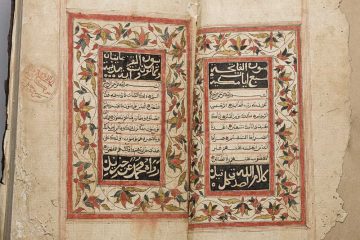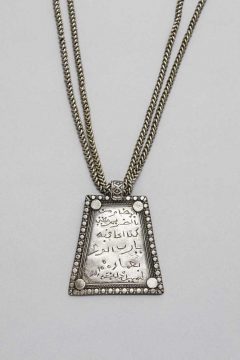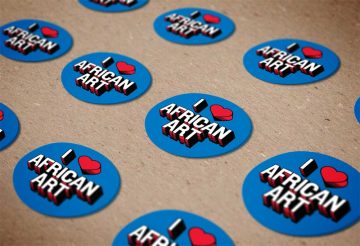

Siyu, Pate Island, Lamu County, Kenya
Qur’an manuscript
c. 19th century
Paper, ink, leather
Lamu Fort Museum, National Museums of Kenya, 10, LFL
Objects in this section demonstrate the significance of language and writing—in roman and Arabic scripts—in Swahili aesthetic expression, especially in devotional contexts. Although diverse in doctrine and practice, most Swahili Coast residents are Muslims who approach the Qur’an and Arabic language with great reverence. Arabic is understood to be the language in which the Word of God was received, and the Qur’an is the materialization of God’s speech. Indeed, sacred words are considered to be endowed with divine attributes. Inscribing and reciting the Word are performative acts through which God intervenes in the world.
The creation of artworks and scholarship dedicated to exploring the sacred significance of writing has been key to Swahili artistry for centuries. The manuscripts on view include Qur’ans exquisitely illuminated in a classical Swahili style designed to intensify the visual presence of the written Word. An array of silver amulet cases and pendants containing specific passages from the Qur’an and esoteric inscriptions derived from its text safeguard their wearers from illness and misfortune.
While letter forms are beautifully ornamented in the art of Qur’anic illumination, words themselves are used to ornament the surfaces of a daunting range of everyday objects. Words on more mundane objects, like the wedding fans and bicycle mud flaps on view, convert them into carriers of the latest slang or timeless moral precepts.
Swahili artist
Swahili Coast
Wedding bowl
19th century
Porcelain
Mombasa Fort Jesus Museum, National Museums of Kenya, 98.1.30

Swahili scribe
Siyu, Pate Island, Lamu County, Kenya
Qur’an manuscript
c. late 18th to 19th century
Paper, ink, leather
Collection of Ahmed Hamid Mohammed Khalfan al Husni
Wearing the Word
Enclosed within ornate silver cases and worn close to the body, amulets are pious invocations and other mystically charged inscriptions derived from the Qur’an that are formulated to address a vast array of personal ailments, afflictions, and life challenges. Prepared by religious specialists with expertise in the curative properties of Qur’anic scripture, amulets vary widely and may include prayers, verses from the Qur’an, the names of God, the angels, and the prophets, or, a myriad of numerological and esoteric formulas.
Amulet cases are often made from silver, a metal thought to have protective properties. The exquisite ornamentation and significant size of several cases here speak to the elite status and wealth of the wearer. When in motion, the dangling clusters of bells extend the amulet’s presence into the realm of sound. The tubular canisters affixed to the Somali, Yemeni, and Kenyan examples enclose amulets made of paper that have been rolled into scrolls. At once intimate and portable, amulets allow devotees to keep the mystical potency of words close to them wherever they may go.



